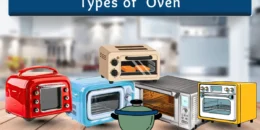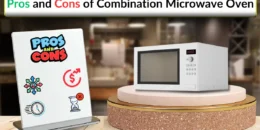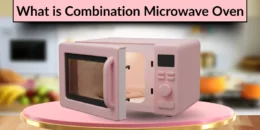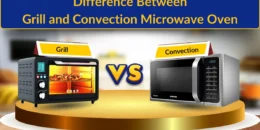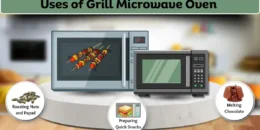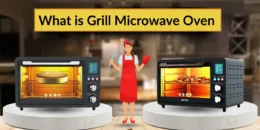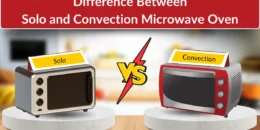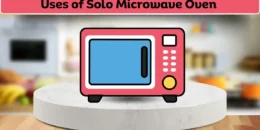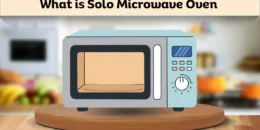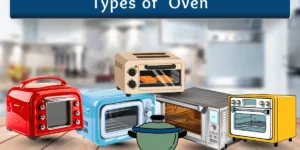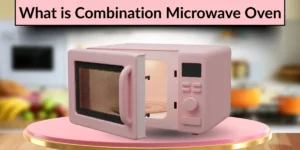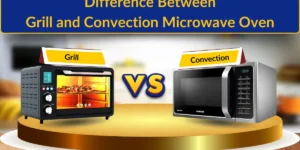Are you confused about which utensils to use in a microwave? Using the wrong utensil can spoil your food or even damage your oven. This microwave oven utensils list will show you which utensils are safe and which ones to avoid. With this guide, you can cook and reheat your food safely every time.
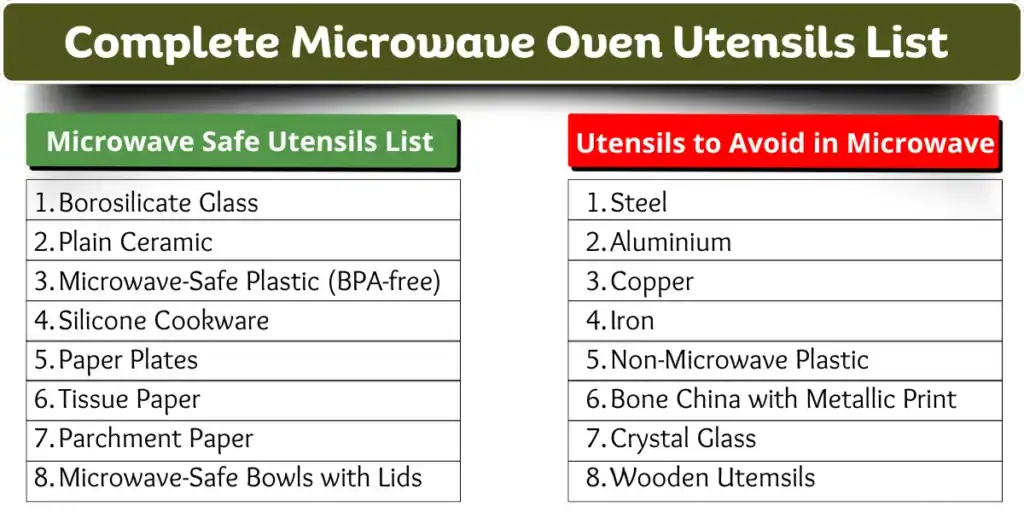
Microwave Safe Utensils List
Microwave makes cooking and reheating very easy. You must always use the right utensils to keep your food safe and your microwave working well. Depending on the types of microwave oven, some utensils may heat faster or slower. Using safe utensils also prevents sparks, cracks, or damage.
Here is a complete microwave oven utensils list that you can use every day:
- Borosilicate Glass
- Plain Ceramic
- Microwave-Safe Plastic (BPA-free)
- Silicone Cookware
- Paper Plates
- Tissue Paper
- Parchment Paper
- Microwave-Safe Bowls with Lids

Borosilicate Glass
Borosilicate glass is very strong and heat resistant. It can handle high microwave temperatures without breaking. You can safely reheat soups, milk, or cooked food in it.
Plain Ceramic
Plain ceramic bowls are safe for microwave use. They heat food evenly without cracking. Avoid ceramic with gold or silver designs. You can use them for cooking, reheating, or serving meals safely.
Microwave-Safe Plastic (BPA-free)
Microwave-safe plastic is light and easy to use. It does not melt or release harmful chemicals when heated. Always choose BPA-free containers with a “Microwave Safe” label.
Silicone Cookware
Silicone cookware is soft and heat-resistant. It can bend without breaking and handle high microwave temperatures. You can use it for baking, steaming, or reheating food. It is easy to clean and lasts a long time.
Paper Plates
Paper plates are lightweight and convenient for microwave use. They heat food quickly without absorbing moisture. Use them for short reheating or serving snacks. Avoid plates with plastic coating or decorations to keep food safe.
Tissue Paper
Tissue paper is thin and safe for short microwave use. You can cover food to prevent splashes while heating. It absorbs some moisture and keeps the microwave clean. Always use plain, unprinted tissue paper for safety.
Parchment Paper
Parchment paper is safe and heat-resistant for microwave use. You can place food on it to prevent sticking and mess. It works well for baking or reheating small items. Always use plain, uncoated parchment paper for the best results.
Microwave-Safe Bowls with Lids
Microwave-safe bowls with lids are very convenient for cooking and reheating. The lids keep food from splashing and retain heat. You can safely store and heat soups, rice, or vegetables in them. Always choose bowls labeled “Microwave Safe” for best results.
Utensils to Avoid in Microwave
Not all utensils are safe for microwave use. Using the wrong items can cause sparks, cracks, or even damage your microwave.
Check this list to know which utensils you should never use:
- Steel
- Aluminium
- Copper
- Iron
- Non-Microwave Plastic
- Bone China with Metallic Print
- Crystal Glass
- Wooden Utensils

Steel
Steel utensils are not safe in a microwave. They can create sparks and damage the oven. Using steel may also burn your food unevenly. Always avoid putting steel bowls or spoons in the microwave.
Aluminium
Aluminium utensils are dangerous in a microwave. They can cause sparks and even start small fires. Heating food in aluminium may also damage the oven.
Copper
Copper utensils are not safe in a microwave. They can create sparks and damage your oven quickly. Using copper may also cause uneven heating of food.
Iron
Iron utensils are unsafe in a microwave. They can produce sparks and may damage the oven. Using iron can also heat food unevenly. Always use safer alternatives like glass, ceramic, or silicone.
Non-Microwave Plastic
Non-microwave plastic is dangerous to use in a microwave. It can melt and release harmful chemicals into food. Heating food in it may ruin both the container and the oven.
Bone China with Metallic Print
Bone china with metallic print is not safe in a microwave. The gold or silver designs can create sparks. Using it may crack the bowl or damage the oven.
Crystal Glass
Crystal glass is unsafe for microwave use. It can crack or shatter when heated. Using it may also damage the microwave.
Wooden Utensils
Wooden utensils are not safe in a microwave. They can dry out, crack, or even catch fire. Using them may ruin your food and oven.
You may also Like these posts:
Types of Oven Explained with Uses & Benefits
Types of Microwave Ovens with Uses – Easy Guide for Home Cooking
Conclusion
So, guys, now let’s wrap up this topic. We have shared a complete microwave oven utensils list with safe and unsafe items. Using the right utensils keeps your food healthy and your microwave safe. Always check labels and avoid dangerous materials. Did this guide help you? Share it with friends or leave a comment below!
FAQs about Microwave Oven Utensils
People often get confused about which utensils are safe in a microwave. These simple FAQs will clear your doubts and make cooking easy for you.
How can I quickly check if a utensil is microwave-safe?
The easiest way is to look for a “microwave-safe” label or symbol at the bottom. If there is no label, do a simple water test. Place the utensil with some water in the microwave and heat for one minute. If water is hot but the utensil stays cool, it is safe. If the utensil becomes hot, do not use it.
Why do some utensils crack or break in the microwave?
Not all utensils can handle sudden temperature changes. Thin glass and low-quality ceramic often crack due to heat stress. Plastic may also melt if it is not microwave-safe. Always use strong and safe materials.
Which utensils are best for daily microwave use?
Glass bowls, plain ceramic plates, and BPA-free plastic containers are the best choices. They are safe, durable, and easy to clean after use. These utensils heat food evenly without any risk. You can use them every day with full confidence.
Can microwave-safe utensils still get hot?
Yes, some utensils can still feel hot after long heating. Glass and ceramic absorb some heat along with the food. Always handle them with oven mitts or a thick cloth. This prevents burns and keeps you safe.
What happens if I use a wrong utensil in microwave by mistake?
Using unsafe utensils may cause sparks or melting. This can spoil your food and even damage the oven. If you see sparks, switch off the microwave immediately. Never ignore such issues as they are risky.
Are disposable plates and cups safe for microwave use?
Plain paper plates and cups are mostly safe for short heating. But plastic-coated or foam ones release harmful chemicals. Printed cups may also burn or smell bad. Always check if they are marked as microwave-safe.
Do lids or covers matter in microwave cooking?
Yes, lids are very helpful in microwave cooking. They keep food moist and stop food splashes inside the oven. Always use microwave-safe covers with a small vent for steam. Never use tight or metal lids as they are unsafe.
How often should I replace microwave utensils?
Plastic utensils should be replaced after a few months if used daily. They develop scratches and may release chemicals over time. Glass and ceramic last longer, but check for cracks. Damaged utensils are unsafe for food heating.
Why should I avoid utensils with metallic prints?
Metallic paint reacts badly with microwave waves. It can create sparks and even damage your oven. These designs may look beautiful but are very risky. Food inside may also get unevenly heated. Always choose plain and simple utensils for safety.
What types of utensils can be safely used in a microwave?
You can safely use glass, plain ceramic, silicone, and microwave-safe plastic in a microwave. These utensils heat food evenly without causing sparks or damage. Always check for a “microwave-safe” label before using. Avoid utensils with metallic designs or coatings to stay safe.


